
As a consequence, it can be compiled on most Unix systems. XPaint also recently acquired a built-in editor which can be used to produce posters containing text and images.Īs XPaint only uses the basic image libraries (PNG, JPEG, JPEG2000, TIFF) along with the X11, Fontconfig and Freetype libraries, it has a very small memory footprint and very few dependencies. The scripting capabilities include programmable filters, batch processing, creation of 2D and 3D images, etc. Recent versions have support for advanced image manipulations (image zooming and resizing, filters, color modifications, separation of RGB channels), scripting, layers, edition of alpha channel and of transparent images, vector formats import, truetype fonts and anti-aliasing, geometric transformations of such fonts, etc. Each paint window has access to its own color palette and set of patterns.
#Aldus photostyler 2 menus windows#
XPaint is divided into a toolbox area, for selecting the current paint operation, and paint windows for modifying/creating images. It can also read and import certain vector formats such as PostScript, PDF, SVG, as well as plain text or TeX, LaTeX files (whenever a TeX system and PostScript/PDF utilities are installed). It allows for editing and browsing multiple images simultaneously, and supports most of the common bitmap formats, including PNG, GIF, TIFF, TGA, PPM, XPM, XBM, BMP, ICO, JPEG, JPEG2000, PGF etc.

XPaint features a substantial number of standard (and less standard) paint operations.


 0 kommentar(er)
0 kommentar(er)
